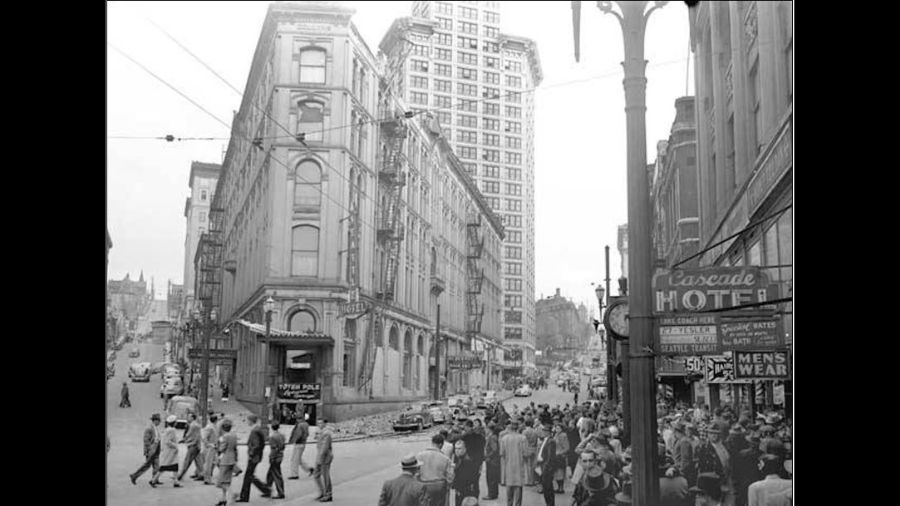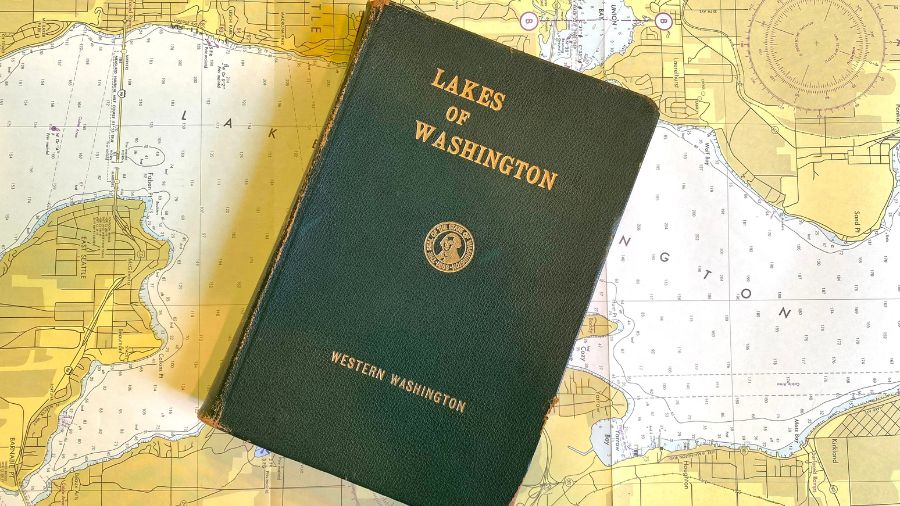Could landmark designation save Seattle’s Memorial Stadium from demolition?
Oct 20, 2021, 10:10 AM | Updated: 10:46 am

Seattle High School Memorial Stadium was built in 1947 to honor Seattle Public Schools alums who died in World War II; the modern look and feel is hard to fully appreciate in total, as the stadium is mostly hidden by other buildings at Seattle Center. (Feliks Banel/KIRO Radio)
(Feliks Banel/KIRO Radio)
When Mayor Jenny Durkan announced a deal with Seattle Public Schools earlier this month — which includes a plan to demolish Memorial Stadium at Seattle Center — there was no mention of an option that would preserve and renovate the 74-year-old facility instead.
The old stadium – officially named “Seattle High School Memorial Stadium” – was built in 1947 in memory of nearly 800 Seattle alums who died in World War II. At the stadium’s east end, facing what was once a grand pedestrian plaza but which Seattle Public Schools turned into a parking lot many years ago, is a Memorial Wall that lists all those names, and which Seattle Center visitors can park their cars almost right up against.
When the mayor announced the demolition plans, no mention was made of the Memorial Wall – but city officials did, in response to KIRO Radio’s inquiries, acknowledge that the wall will be preserved as part of any new project.
But, what if the wall was only part of the memorial? What if the reality is that the entire stadium is the memorial? In fact, the stadium was completed and in operation as “Seattle High School Memorial Stadium” for almost four years before the wall was dedicated in 1951.
As it turns out, this may not be just some pedantic argument or splitting of historic preservation hairs.
University of Washington architecture professor and architectural historian Jeffrey Karl Ochsner says that the late 1940s was all about facilities themselves serving as memorials – not just freestanding statues or shrines.
“In the post-World War II era, it was very typical that functional buildings and works of engineering were designated as memorials, rather than building separate structures that served as memorials, but had no other purpose,” Ochsner told KIRO Radio.
The stadium at what’s now Seattle Center was designed by architect George Wellington Stoddard and it was named “Seattle High School Memorial Stadium” before World War II had even ended. Suggestion for the name came from school board member James A. Duncan sometime before June 1945, and was then officially adopted by the board in February 1946.
Researcher Lee Corbin found several newspaper stories about the stadium from before and during construction that reveal how the entire facility was regarded as the memorial.
On March 2, 1947, the Seattle Post-Intelligencer wrote: “Not just a huge mass of concrete surrounding a gridiron field but ultra modern in every detail, the stadium will be just what Seattle citizens intended it to be — a truly living war memorial.”
This was four years before the wall of names was added.
Other clippings Corbin found include The Seattle Times from Feb. 3, 1946, which said “the stadium has been named in memory of Seattle public school pupils who died in the Second World War.” On Nov. 30, 1947, The Spokesman-Review of Spokane wrote, “The field is dedicated to World War II victims from Seattle and King County.”
Despite its role in honoring war deaths of locals, Memorial Stadium is not currently on any historic register, and it’s never been officially considered by the Seattle Landmarks Board.
However, Jeffrey Karl Ochsner says the facility easily qualifies as a landmark under several official criteria. One reason is because the architect – George Wellington Stoddard – is a significant, if not well-known, figure in the Pacific Northwest. He also designed Green Lake Aqua Theatre, the south grandstand at Husky Stadium, the octagonal former gas station on Denny Way, and Victory Square, the temporary monument to war dead created downtown during World War II.
Ochsner says architectural pedigree is only part of Memorial Stadium’s landmark bonafides.
“It’s also certainly significant for its cultural history as the center of so many different kinds of celebrations and activities. I mean, how many generations of Seattleites went to that building for football games, for graduations, for other ceremonies?” Ochsner said. “And then it got another layer of significance from the role it played in the Century 21 World’s Fair, and all of the ceremonies and activities that took place there.”
“So clearly, the building qualifies under the landmarks designation on multiple criteria,” Ochsner continued. “It would also easily qualify for the National Register of Historic Places.”
Another researcher – retired Seattle Times writer Bill Kossen – uncovered other details about the stadium’s construction that might also support its landmark designation, including that the 1947 concrete roof was the first of its kind built over a stadium. Two decades later in 1967, Kossen discovered, Memorial Stadium became the first high school football field in the country to install Astroturf.
Chris Moore is executive director of the Washington Trust for Historic Preservation, the nonprofit group that advocates, among other things, for not simply keeping old buildings as museum pieces, but for making them relevant and dynamic parts of their community.
On the day after the Foo Fighters christened it and a few days before the Seattle Kraken make their home ice debut there, Moore sees a lot of parallels between the original Seattle Center Coliseum – now known as Climate Pledge Arena – and its dowdy and neglected neighbor.
“It was not that long ago at all when there was talk about demolishing KeyArena,” Moore said. “You know, ‘It’s a white elephant. What can we do with it? The Sonics are gone. It’s just sitting there. It needs to be upgraded. We’ve got to do something else.’ And look at it now.”
“And then to think that you now have this Memorial Stadium, literally, echoing, kind of a mirror of KeyArena,” Moore continued. “And it was only completed 15 years before KeyArena.”
The two buildings are from distinctly different eras, says Moore, but their proximity means that they are in a conversation or dialog, architecturally and historically speaking. And, the success of Climate Pledge Arena makes it clear that Memorial Stadium offers a lot of potential for a similarly creative approach to rehabilitation and preservation.
In her announcement of the new plan, the mayor mentioned the shabby condition of the stadium.
“Students from across the district should not have to play in facilities that are in disrepair,” Mayor Durkan said in a press release. “We owe it to the youth of our City for generations to come to build a first-class facility in the heart of our transforming Seattle Center.”
In a written statement provided to KIRO Radio, nonprofit preservation group Historic Seattle’s preservation advocacy manager Jeff Murdock said, “a property’s poor condition is not a factor in determining eligibility [for landmark designation]; it simply means that a property suffers from deferred maintenance.”
The truth is, Memorial Stadium may look shabby, but it’s structurally safe, and still in regular use by thousands of visitors each year – and it also survived big earthquakes in 1949, 1965, and 2001. Preserving Memorial Stadium and the mayor’s “first-class facility in the heart of our transforming Seattle Center” are not, as some might believe, mutually exclusive.
Chris Moore says that when he hears talk of Memorial Stadium’s tired condition as a reason for demolition, the whole thing starts to sound like KeyArena all over again.
“To talk about it in terms of, ‘Oh, it’s in disrepair, needs to be torn down, needs to go away. It doesn’t fit.’ Let’s not forget that those were the exact same conversations being used to potentially justify removing KeyArena, which, thank God, never happened,” Moore told KIRO Radio.
The City of Seattle and the school district declined interview requests. In an email, Seattle Public Schools spokesperson Tim Robinson said it’s too early to speak with the media.
“At this time, we’re holding off on interviews regarding the issue,” Robinson said. “It’s primarily because of the very early nature of all of this and, as of yet, there are no concrete plans.”
According to Mayor Durkan’s announcement, the potential ballot measure is just four months away. That doesn’t make a conversation now with school district seem “very early” at all.
In fact, Jeff Murdock of Historic Seattle said in his statement that the city “should submit a nomination to the Landmarks Preservation Board to ascertain the property’s eligibility as a city landmark BEFORE asking voters to vote on a levy to fund a replacement stadium.”
The tone and tenor of Mayor Durkan’s announcement gave the sense that demolition was a foregone conclusion, which does a disservice to Seattle Public Schools’ war dead in whose name the stadium was built. It also games the city’s own historic preservation process, which both public and private landowners are required to navigate.
Historic Seattle’s Jeff Murdock touches on this as well, as he writes, “we consistently advocate for city agencies to determine the historic significance of properties before hiring designers and building support for public projects. Instead of treating the Landmarks Preservation Ordinance as an afterthought, the process can inform more timely decisions on whether a property should or could be rehabilitated instead of demolished.”
Meanwhile, board president Maureen Elenga of the nonprofit Queen Anne Historical Society told KIRO Radio via email that her group is “not opposed to the redevelopment of the Seattle High School Memorial Stadium site; but we do want the memorial wall to be preserved, and preferably given a place of prominence on the property.”
Asked to clarify whether or not the society would support preservation of Memorial Stadium, Elenga wrote, “We won’t have an opinion on any potential plans until we see what all of the options are.”
It’s the “until we see what all of the options are” part of Elenga’s email that best captures how the goalposts for Seattle High School Memorial Stadium have been continually moved for the past several years, as multiple Seattle mayors — including Greg Nickels, Ed Murray, and Tim Burgess — presided over various attempts to come to some agreement with the school district.
The next moves – in the process, not for the goalposts – are likely up to the City of Seattle and Seattle Public Schools as to whether they will speak with anyone about their plans, and whether they will decide – or be compelled – to fully and sincerely explore Memorial Stadium’s historic significance and eligibility to be declared a landmark.
Chris Moore is intrigued by what might come next, especially given the community’s original intent more than 75 years ago that the entire stadium honor local members of the Greatest Generation. How the community continues to respect and honor the memory of those Seattle alums who gave their life fighting in World War II should be part of the discussion, especially given how much negative attention has been focused lately on demolishing Confederate memorials around the country, including in Washington.
“You can open up a whole other can of worms with that right now with the discussions that are happening nationally around war memorials,” Moore said. “But I think this one is probably on the right side of history.”
You can hear Feliks every Wednesday and Friday morning on Seattle’s Morning News, read more from him here, and subscribe to The Resident Historian Podcast here. If you have a story idea, please email Feliks here.













